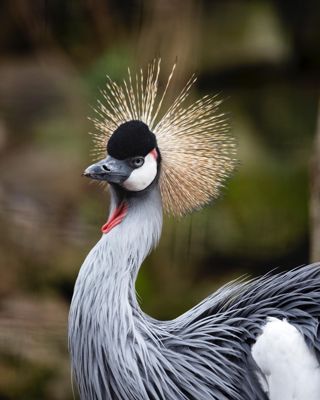
East African Grey Crowned Crane

General Information
Standing tall at about 1 metre, weighing a nimble 3.5 kg, and boasting an impressive wingspan of 2 metres, this bird is a marvel to behold!
The head has a crown of striking golden feathers. The sides of the face are white, and there is a bright red inflatable throat patch. The bill is relatively short and grey and the legs are black. They have long legs for wading through the grasses and shallow bodies of water.
The grey crowned crane has a breeding display involving dancing, bowing, and jumping. It has a booming call that involves inflation of the red gular sac. It also makes a honking sound quite different from the trumpeting of other crane species.

Latin name - Balearica regulorum
Class - Aves
Order - Gruiformes
Family - Gruidae
IUCN Status - Endangered
Habitat - Dry savannah, marshes, cultivated lands and grassy flatlands near rivers and lakes
Distribution - Sub-Saharan Africa
Grey crowned cranes are omnivorous - eating vegetation, seeds, grain, insects, frogs, worms, snakes, small fish, and aquatic animals' eggs. Stamping their feet as they walk, they flush out insects that are quickly caught and eaten. The birds also associate with grazing herbivores, benefiting from the ability to grab prey items disturbed by other animals passing through long grasses.
Although the grey crowned crane remains common over some of its range, it faces threats to its habitat due to drainage, overgrazing, and pesticide pollution. Their global population is estimated to be between 58,000 and 77,000 individuals. In 2012 it was uplisted to endangered by the IUCN.
Fun Fact
Primitive species of crowned cranes date back in the fossil record to the Eocene Epoch! (56 to 33.9 million years ago).

Sign up to our newsletter
Join our mailing list in order to keep up to date with Zoo news and special offers.

